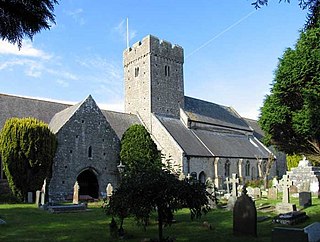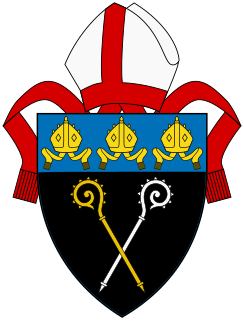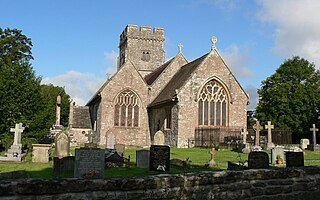Related Research Articles

Colwinston is both a village and a community in the Vale of Glamorgan, Wales, approximately 4 miles (6.4 km) southeast of the centre of Bridgend and 21 miles (34 km) west of the centre of Cardiff. The village is located within 1⁄2 mile (0.80 km) of the A48. The population in 2005 was approximately 400 but with recent building development, the population is now estimated at over 600 people.

St Illtyd's Church is a church complex in Llantwit Major, Vale of Glamorgan, southeast Wales. It is located at the site of the oldest college in the United Kingdom, once believed to have been founded as Côr Tewdws c. AD 395 by the Roman Emperor Theodosius II. It is now generally accepted as having been founded by St. Illtud c. AD 508, from whom it derives its name. The current church building was built in the 11th century by the Normans, with portions being rebuilt in the 13th and 15th centuries. The church building is one of the oldest and best-known parish churches in Wales. It is a grade I listed building, or building of exceptional interest, and has been called both the "Westminster Abbey of Wales" for its unique collection of carved stones and effigies, and "the most beautiful church in Wales."

The Diocese of Llandaff is an Anglican diocese that traces its roots to pre-Reformation times as heir of a Catholic bishopric. It is headed by the Bishop of Llandaff, whose seat is located at the Cathedral Church of Saint Peter and Saint Paul in Llandaff, a suburb of Cardiff. It currently covers most of the former Welsh county of Glamorgan, but once stretched from the River Towy to the middle of the Wye Valley.
Urban was the first bishop of South East Wales to call himself 'bishop of Llandaff'. He was of a Welsh clerical family and his baptismal name in the Welsh language is given in charter sources as Gwrgan. He Latinised it to the papal name 'Urban'.

Llantarnam Abbey is a Grade II*-listed abbey of the Sisters of St Joseph of Annecy and a former Cistercian monastery located in Llantarnam, Cwmbran in the county borough of Torfaen in southeast Wales.

Saint Padarn's Church is a parish church of the Church in Wales, and the largest mediaeval church in mid-Wales. It is at Llanbadarn Fawr, near Aberystwyth, in Ceredigion, Wales, United Kingdom.
Ewyas was a possible early Welsh kingdom which may have been formed around the time of the Roman withdrawal from Britain in the 5th century. The name was later used for a much smaller commote or administrative sub-division, which covered the area of the modern Vale of Ewyas and a larger area to the east including the villages of Ewyas Harold and Ewyas Lacy.

St Hilary is a village in the Vale of Glamorgan, Wales. It is located just south of the A48, about a mile southeast of the market town of Cowbridge. The village has a population of about 260, in approximately 80 houses. Notable landmarks in the vicinity include The Bush Inn, the Church of St Hilary, the Old Beaupre Castle, New Beaupre, Coed Hills and St. Hilary mast.

John Prichard was a Welsh architect in the neo-Gothic style. As diocesan architect of Llandaff, he was involved in the building or restoration of many churches in south Wales.
Roy Thomas Davies was a Welsh Anglican clergyman, who served as Bishop of Llandaff from 1985 to 1999.
Edward James was a Welsh Anglican priest and translator.

The Scottish surname Lingo is derived from the lands of Lingoch in the parish of Carnbee, Fife, Scotland. The earliest known recorded use of the surname in Scotland is by Ulf de Lingoch, who witnessed a charter granted in the early 13th century.
John Véron was a French Protestant controversialist and preacher, known for his activities in England.

The Parish Church of St Hilary is a Grade II* listed Anglican church in the village of St Hilary in the Vale of Glamorgan, south Wales. It is one of 11 churches in the Parish of Cowbridge. It became a listed building on 22 February 1963.
John Montgomery Traherne, FRS, FSA, FGS, FLS, was a Welsh Anglican priest, antiquarian, magistrate and Deputy Lieutenant of County of Glamorgan. His best known work is Historical Notices of Sir Matthew Craddock of Swansea.

Flemingston is a small village in the Vale of Glamorgan in south Wales. It is located 8.5 miles (13.7 km) northwest by road from the town centre of Barry. It contains the Church of St. Michael the Archangel, the ruins of Flemingston Court, and Flemingston Manor or Grange, all of which are listed buildings. Historically, the parish of Flemingston was a sub-manor of Aberthaw or St Athan.

Llanilid is a small settlement of in the county borough of Rhondda Cynon Taf, Wales. It is in the historic county of Glamorgan. Llanilid is part of the community of Llanharan along with the villages of Bryncae, Brynna, Ynysmaerdy, Peterston-super-Montem and Llanharan itself.

Saint Ilid is a semi-legendary saint of Wales. He has at times been identified as Joseph of Arimathea, perhaps because he is referred to as a "man of Israel" and to have been born Jewish. Moreover, he is said to have returned from Rome with Caratacus, Saint Cyllin and Eigen and formed a religious college of twelve named Cor Eurgain, suggesting the early entry of Christianity into Britain. He may be commemorated in the village Llanilid. According to Thomas Morgan, Llanilid follows the tradition of Welsh place names attached to a parish in taking its title from the saint to whom the local church is dedicated. In Llanilid the local church is St. Ilid & St Curig's church, and Morgan states that this relates to Ilid a person who introduced Christianity to Wales in the 1st century. This research may be connected to that of famed literary forger Iolo Morganwg, who produced elaborate tales of Ilid going as far as stating that it was the Welsh names of Joseph of Arimathea. Morgan relates that "Llan" – "Ilid", refers to the 'parish of St Ilid'. This has been challenged by R. W. D. Fenn, who, after studying the Book of Llandaff and Nennius's Historia Brittonum writes in 1962 that the Latin equivalent of Ilid represents the name of a district, similar to Llandovery, and not a person. Fenn then writes that in 1566 Llanilid was dedicated to Ilid and Curig, whom he connects to the saints more commonly known in Christian tradition as Julietta and Quiricus. He links this through the Appendix of the Book of Llandaff which states that the church at Llanilid is first given as the 'Church of St Julitta'.
Alun Radcliffe Davies was a Welsh Anglican priest in the last third of the twentieth century.
John Ebden was an English priest.